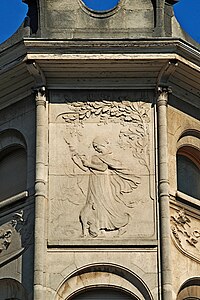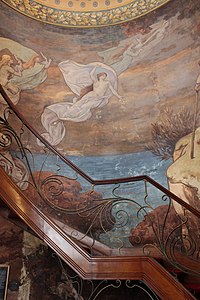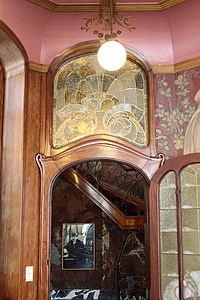Hôtel Hannon
| Hôtel Hannon | |
|---|---|
 Main façades of the Hôtel Hannon | |
 | |
| General information | |
| Type | Town house |
| Architectural style | Art Nouveau |
| Address | Avenue de la Jonction / Verbindingslaan 1 |
| Town or city | 1060 Saint-Gilles, Brussels-Capital Region |
| Country | Belgium |
| Coordinates | 50°49′15″N 4°21′08″E / 50.82083°N 4.35222°E |
| Construction started | 1903 |
| Completed | 1904 |
| Design and construction | |
| Architect(s) | Jules Brunfaut |
The Hôtel Hannon (French: Hôtel Hannon; Dutch: Hotel Hannon) is a historic town house in Brussels, Belgium. Constructed between 1903 and 1904, in Art Nouveau style, for the industrialist Édouard Hannon, it is the only house in that style designed by the architect Jules Brunfaut.[1]
The Hôtel Hannon is located at 1, avenue de la Jonction/Verbindingslaan, at the corner of the Avenue Brugmann/Brugmannlaan, in the municipality of Saint-Gilles, "in a neighbourhood which, even today, remains a sacred district of architectural jewels."[2]
History[edit]
Édouard Hannon was an engineer with Solvay S.A., a major chemicals company, and the long-time manager of Solvay's sodium carbonate plant at Dombasle-sur-Meurthe, just south of Nancy, France. He was also a painter, art critic and photographer.[3]
Hannon gave the task of conceiving and building his new house to his friend Jules Brunfaut, asking him to use the Art Nouveau style that Hannon loved very much and that was popular both in Brussels and Nancy. The house was occupied by the Hannon family until 1965. Upon the death of the original owner's daughter, the property was abandoned, vandalised, and eventually threatened with demolition.[1] In 1973, Jules Brunfaut's daughter consulted the Royal Commission of Monuments and Sites and made enquiries as to the status of this work of her father, which was still unoccupied;[2] as a result of her efforts, the building's exterior was classified as a protected monument in 1976.[1] The building was acquired by the municipality of Saint-Gilles in 1979,[3] the interior was classified in 1983, and the building underwent a significant renovation between 1984 and 1989.[1]
In 1988,[2] the Hôtel Hannon was put at the disposal of the Espace photographique Contretype,[3] which, in addition to conserving the photographic work of Édouard Hannon, works to promote creative photography through expositions, retrospectives of artists, conferences and their publications. After having occupied the Hôtel until 2014, Contretype moved to the Cité Fontainas, another building in Saint-Gilles.[3]
In 2022, the entirely renovated building will become a museum, under the auspices of the team at the Horta Museum. Visitors will be able to rediscover the furniture of Émile Gallé, which will return to its original home.[4]
Architecture[edit]
The façades of the Hôtel Hannon combine white brick, limestone, and blue stone.[1] The house has two very asymmetrical façades: a short one of a single bay on the Avenue Brugmann, and a more important façade of two bays on the Avenue de la Jonction, with the two façades joined by a three-bay angular span between them.[1] The façade of the Avenue de la Jonction presents a play of volumes in projections and recesses. Its central bay carries a large bay window comprising a limestone base, a chassis in wood that holds a stained glass window by Raphaël Évaldre and a roof covered in zinc, surmounted by a setback of the upper floors, pierced by a triplet of windows on the first floor and a pair of windows on the second floor.[1]
The corner, consisting of three bays, is ornamented with a remarkable wrought iron balcony undergirded by a stone substructure that extends from the base to the first floor, where they "open into volutes." The upper level of the corner bay is decorated with a large bas-relief by Victor Rousseau entitled La fileuse ("The spinner"), which is an allegory of Time.[1]
The building is a rather clumsy Art Nouveau design, and Brunfaut's discomfort with the style is evident, but the architect nonetheless took some cues from his fellow, more adept Art Nouveau designer Victor Horta, such as the impressive central staircase, a typical design element in Horta's residences such as the Hôtel Tassel, the Hôtel Solvay, and the Hôtel van Eetvelde.
-
Oriel and bays facing the Avenue de la Jonction
-
Oriel
-
Base of the oriel
-
Corner bays
-
La fileuse, bas-relief by Victor Rousseau
Interior[edit]
The architect called on numerous artists for the building's interior and exterior decoration. The conception of the furniture (which will return to the house in 2022 with the opening of the museum) and the interior decoration is the work of Émile Gallé and Louis Majorelle. Certain frescoes in the smoking room and the stair hall are the work of the painter Paul Albert Baudouin.[5] The staircase ironwork is by Pierre Desmedt, and the stained glass the work of Raphaël Évaldre.
-
Stair hall fresco
-
Stair hall fresco
-
Stair hall fresco
-
Stair hall mosaic
-
Stained glass
See also[edit]
- List of museums in Brussels
- Art Nouveau in Brussels
- History of Brussels
- Culture of Belgium
- Belgium in the long nineteenth century
References[edit]
- ^ a b c d e f g h L'Hôtel Hannon sur le site de l'inventaire du patrimoine architectural de la Région de Bruxelles-Capitale
- ^ a b c Karim Fadoul (28 July 2003). "Les cent ans de l'Hôtel Hannon". DH Les Sports+.
- ^ a b c d "L'Hôtel Hannon sur le site de l'Espace photographique Contretype". Archived from the original on 29 December 2017. Retrieved 8 May 2021.
- ^ "Une journée à Saint-Gilles, la commune relax de Bruxelles". 27 March 2021.
- ^ Piet Swimberghe, Living in Brussels. Lannoo Uitgeverij, pp. 126–128. ISBN 9020949799.










